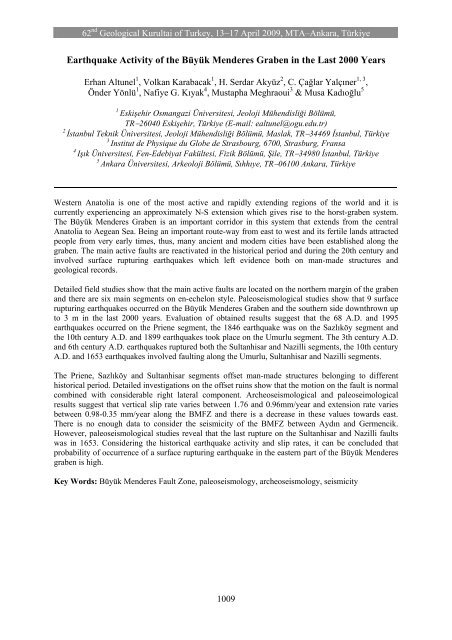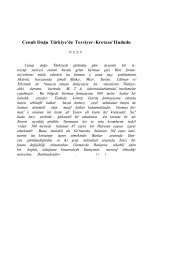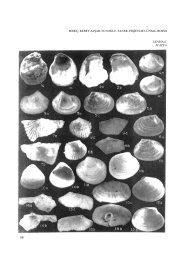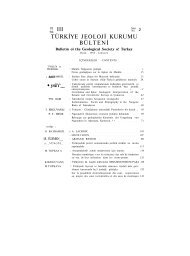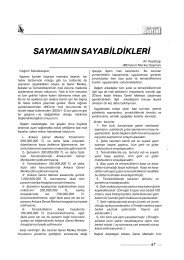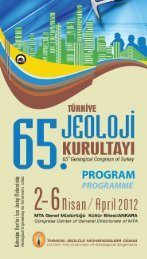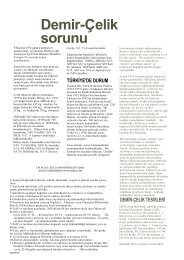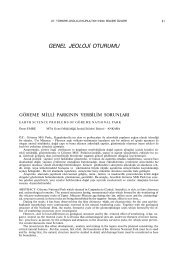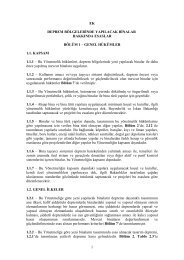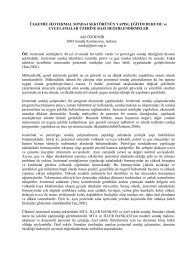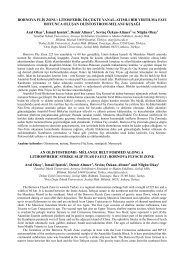Paleosismoloji ve Arkeosismoloji Palaeoseismology and ...
Paleosismoloji ve Arkeosismoloji Palaeoseismology and ...
Paleosismoloji ve Arkeosismoloji Palaeoseismology and ...
You also want an ePaper? Increase the reach of your titles
YUMPU automatically turns print PDFs into web optimized ePapers that Google loves.
62 nd Geological Kurultai of Turkey, 13−17 April 2009, MTA–Ankara, Türkiye<br />
Earthquake Activity of the Büyük Menderes Graben in the Last 2000 Years<br />
Erhan Altunel 1 , Volkan Karabacak 1 , H. Serdar Akyüz 2 , C. Çağlar Yalçıner 1, 3 ,<br />
Önder Yönlü 1 , Nafiye G. Kıyak 4 , Mustapha Meghraoui 3 & Musa Kadıoğlu 5<br />
1<br />
Eskişehir Osmangazi Üni<strong>ve</strong>rsitesi, Jeoloji Mühendisliği Bölümü,<br />
TR−26040 Eskişehir, Türkiye (E-mail: ealtunel@ogu.edu.tr)<br />
2<br />
İstanbul Teknik Üni<strong>ve</strong>rsitesi, Jeoloji Mühendisliği Bölümü, Maslak, TR−34469 İstanbul, Türkiye<br />
3<br />
Institut de Physique du Globe de Strasbourg, 6700, Strasburg, Fransa<br />
4<br />
Işık Üni<strong>ve</strong>rsitesi, Fen-Edebiyat Fakültesi, Fizik Bölümü, Şile, TR−34980 İstanbul, Türkiye<br />
5<br />
Ankara Üni<strong>ve</strong>rsitesi, Arkeoloji Bölümü, Sıhhıye, TR−06100 Ankara, Türkiye<br />
Western Anatolia is one of the most acti<strong>ve</strong> <strong>and</strong> rapidly extending regions of the world <strong>and</strong> it is<br />
currently experiencing an approximately N-S extension which gi<strong>ve</strong>s rise to the horst-graben system.<br />
The Büyük Menderes Graben is an important corridor in this system that extends from the central<br />
Anatolia to Aegean Sea. Being an important route-way from east to west <strong>and</strong> its fertile l<strong>and</strong>s attracted<br />
people from <strong>ve</strong>ry early times, thus, many ancient <strong>and</strong> modern cities ha<strong>ve</strong> been established along the<br />
graben. The main acti<strong>ve</strong> faults are reactivated in the historical period <strong>and</strong> during the 20th century <strong>and</strong><br />
invol<strong>ve</strong>d surface rupturing earthquakes which left evidence both on man-made structures <strong>and</strong><br />
geological records.<br />
Detailed field studies show that the main acti<strong>ve</strong> faults are located on the northern margin of the graben<br />
<strong>and</strong> there are six main segments on en-echelon style. Paleoseismological studies show that 9 surface<br />
rupturing earthquakes occurred on the Büyük Menderes Graben <strong>and</strong> the southern side downthrown up<br />
to 3 m in the last 2000 years. Evaluation of obtained results suggest that the 68 A.D. <strong>and</strong> 1995<br />
earthquakes occurred on the Priene segment, the 1846 earthquake was on the Sazlıköy segment <strong>and</strong><br />
the 10th century A.D. <strong>and</strong> 1899 earthquakes took place on the Umurlu segment. The 3th century A.D.<br />
<strong>and</strong> 6th century A.D. earthquakes ruptured both the Sultanhisar <strong>and</strong> Nazilli segments, the 10th century<br />
A.D. <strong>and</strong> 1653 earthquakes invol<strong>ve</strong>d faulting along the Umurlu, Sultanhisar <strong>and</strong> Nazilli segments.<br />
The Priene, Sazlıköy <strong>and</strong> Sultanhisar segments offset man-made structures belonging to different<br />
historical period. Detailed in<strong>ve</strong>stigations on the offset ruins show that the motion on the fault is normal<br />
combined with considerable right lateral component. Archeoseismological <strong>and</strong> paleoseimological<br />
results suggest that <strong>ve</strong>rtical slip rate varies between 1.76 <strong>and</strong> 0.96mm/year <strong>and</strong> extension rate varies<br />
between 0.98-0.35 mm/year along the BMFZ <strong>and</strong> there is a decrease in these values towards east.<br />
There is no enough data to consider the seismicity of the BMFZ between Aydın <strong>and</strong> Germencik.<br />
Howe<strong>ve</strong>r, paleoseismological studies re<strong>ve</strong>al that the last rupture on the Sultanhisar <strong>and</strong> Nazilli faults<br />
was in 1653. Considering the historical earthquake activity <strong>and</strong> slip rates, it can be concluded that<br />
probability of occurrence of a surface rupturing earthquake in the eastern part of the Büyük Menderes<br />
graben is high.<br />
Key Words: Büyük Menderes Fault Zone, paleoseismology, archeoseismology, seismicity<br />
1009


